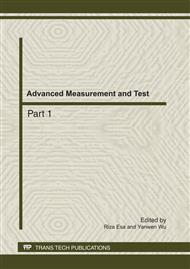[1]
H. Hayakawa: Photometric Stereo Under a Light Source with Arbitrary Motion. Journal of Optical Society of America Vol. 11 (1994), pp.3079-3089.
DOI: 10.1364/josaa.11.003079
Google Scholar
[2]
P. Belhumeur, D. Kriegman and A. Yuill, in: The Bas-relief Ambiguity, Proceedings of Computer Vision and Pattern Recognition, pp.1040-1046, IEEE CS Press (1997).
DOI: 10.1109/cvpr.1997.609461
Google Scholar
[3]
A. Yuille and D. Snow, in: Shape and Albedo from Multiple Images Using Integrability, Proceedings of Computer Vision and Pattern Recognition, pp.158-164, IEEE CS Press (1997).
DOI: 10.1109/cvpr.1997.609314
Google Scholar
[4]
A. S. Georghiades, in: Incorporating the Torrance-Sparrow Model of Reflectance in Uncalibrated Photometric Stereo, Proceedings of International Conference of Computer Vision, pp.816-823, IEEE CS Press (2003).
DOI: 10.1109/iccv.2003.1238432
Google Scholar
[5]
A. Hertzmann and S. M. Seitz: Example-based Photometric Stereo: Shape Reconstruction with General, Varying BRDFs. IEEE Transactions on Pattern Analysis and Machine intelligence, vol 27 (2005), pp.254-264.
DOI: 10.1109/tpami.2005.158
Google Scholar
[6]
T. B. Chen, M. Goesele and H. P. Seidel, in: Mesostructure from Specularity, Proceedings of Computer Vision and Pattern Recognition, pp.825-832, IEEE CS Press (2006).
DOI: 10.1109/cvpr.2006.182
Google Scholar
[7]
Y. Francken, T. Cuypers, T. Mertens, J. Gielis and P. Bekaert, in: High Quality Mesostructure Acquisition Using Specularities, Proceedings of Computer Vision and Pattern Recognition, pp.1-7, IEEE CS Press (2008).
DOI: 10.1109/cvpr.2008.4587782
Google Scholar
[8]
R. Woodham: Photoetric Method for Determining Surface Orientation from Multiple Images. Optical Engieering, Vol. 19 (1980), pp.139-144.
Google Scholar
[9]
D. A. Forthy and J. Ponce: Computer Vision: A Modern Approach (Prentice Hall, New York 2003).
Google Scholar
[10]
J. Canny and C. John: A Computational Approach to Edge Detection. IEEE Transactions on Pattern Analysis and Machine Intelligence, Vol. PAMI-8, 6 (1986), pp.679-698.
DOI: 10.1109/tpami.1986.4767851
Google Scholar
[11]
D. Shreiner and the Khronos OpenGL ARB Working Group: OpenGL Programming Guide (Seventh Edition) (Pearson Education Inc., New York 2009).
Google Scholar


